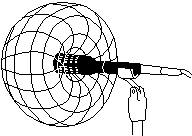A microphone changes sound into electricity.
There are two main types that you're likely to come across. Dynamic and Condenser. Within these two general types there are a multitude of variations of handheld, tie-clip (lavalier), lectern, ceiling, boundary and instrument microphones.
Don't be tempted to buy a dozen Shure SM58s and use them for everything. The SM58 was designed 35 years ago and there have been some minor advances in technology since then (like the pocket calculator!) They're still excellent at what they do, but they are Dynamic Cardioid microphones and there are other mics that are better at particular jobs.
Choosing which microphone to use for a particular application requires experience - either asking somebody who knows, or going into a supplier or music shop and trying every microphone they've got. It's important to buy quality, but that doesn't necessarily mean the most expensive microphone. The things to look for when you're trying out mics are handling noise, feedback resistance and - does it make you sound good!
Dynamic microphones. If you did physics at school, you may know that electricity is generated when you move a metal coil over a magnet. That's how a dynamic microphone works. When you make a sound, the air vibrates. This moves a thin 'diaphragm' (which has a coil attached to it) over a magnet. The coil is then connected to your cable.
Dynamic microphones are very robust. They can take a lot of abuse, and they are relatively inexpensive. Where they fall down is picking up sounds that are far away. They're not very sensitive. They're not ideal for lectern mics, and they're useless for hanging from the ceiling to try to record a church congregation.
Condenser microphones work slightly differently. They have two plates. The air vibrating from the sound moves one of them relative to the other and the voltage changes. this change is then amplified and connected to the cable. Condenser microphones need to be powered, either by a battery or (preferably) by phantom power.
Condenser mics are more expensive than dynamic mics, but the sound reproduction can be much more accurate, and they're generally more sensitive - making them ideal for picking up groups of singers or instruments. They can also be very small and inconspicuous
Cardioid microphones have a heart-shaped pickup pattern. Probably the most common microphones in use today, They reject sound coming from the back of a microphone and are progressively more sensitive to sounds as the direction approaches the front of the microphone. They are favoured for stage use as they do not pick up the sound from on stage speakers or monitors so readily, thus preventing feedback.

There are versions of the Cardioid pattern called Supercardioid and Hypercardioid, which represent increasingly limited ranges of pickup. As the pattern narrows, feedback rejection improves even more, but due to limitations of construction, a narrowing of the pattern does add a little sensitivity directly behind the microphone. The narrowing does cause the sound recorded to be more pinched and less flattering, but in a stage situation with many speakers placed in unsuitable places, a hypercardioid microphone can be a highly effective feedback prevention measure.
Directional microphones should be limited to no more than two people using them at the same time, and should preferably be one per person.
Proximity Effect
Cardioid microphones have a phenomenon called the Proximity Effect. The bass increases as the microphone moves nearer the sound source. Similarly, the further a cardioid microphone is from a source of sound, the more tinny it will sound. Experienced vocalists and producers have used this phenomenon to great effect, especially in simulating a punchy, 'live' effect by almost eating the microphone while singing. The proximity effect can also cause problems, especially when dealing with inexperienced speakers, as the tonal qualities of his or her voice will change as he or she moves his head.